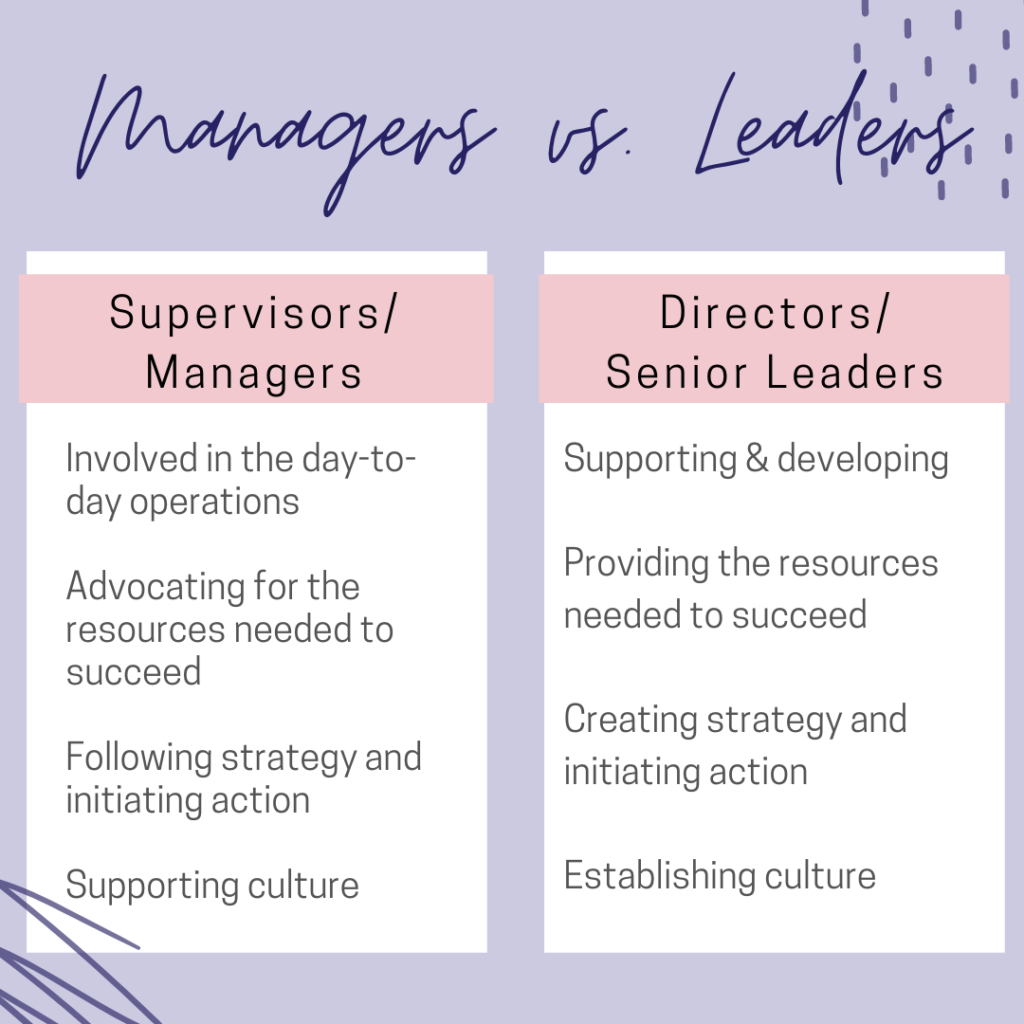When you hear the words ‘leader’ and ‘manager’, do you think of two completely different people? Or the same? There are many similarities between the role of leaders and the role of managers, but they are not necessarily the same.
Leadership vs. Management – What’s The Difference?
Being a leader requires us to think on our feet and to lead from the front. We must be willing to take criticism and to learn from others. A leader is somebody who can command attention with their words and actions. Leadership development starts with SELF-leadership. It takes continuous development.
Self-leadership includes mindset, emotional intelligence, and time management. All of these require leaders to be self-aware and to embrace change.
A manager is somebody who can give commands and let people know what needs to be done. The work of managers is vital to an organization’s ability to achieve big goals.
Leadership and management go hand in hand and are often used interchangeably. The nuisance is that leadership describes a one-to-many relationship and management is the one-to-one relationship between an employee and their direct supervisor. So what are the other differences?
Here are 4 key differences between the role of managers and the role and responsibilities of leaders.
1. Managers handle the day-to-day operations; Leaders support and develop processes.
Managers measure, analyze, and communicate results. They handle the nitty-gritty, day-to-day tactical operations. Managers implement processes and handle coaching conversations to support employee achievements.
The nitty-gritty of the work of managers is getting the work done. Juggling their own work output with managing the work output of others. Trying to balance spending time with employees, attending back-to-back meetings, and putting out fires. Successful managers develop systems and processes to monitor progress and provide the right level of oversight.
Leaders provide support to ensure that the day-to-day tactical operations are running most efficiently. If they are not, then a leader’s job is to develop processes to make the manager’s life easier. Leaders look at the big picture. They have to look at the many moving pieces within the organization to ensure everything is running cohesively and moving the company towards reaching its goals.
2. Managers advocate for the resources the team needs to succeed; Leaders provide the needed resources.
 Since managers handle the day-to-day operations, they see firsthand the needs of the team. They can identify bottlenecks, roadblocks, or other challenges, as well as determine what resources they need to eliminate those challenges and blocks. Managers can take that information and those realizations to the leadership team.
Since managers handle the day-to-day operations, they see firsthand the needs of the team. They can identify bottlenecks, roadblocks, or other challenges, as well as determine what resources they need to eliminate those challenges and blocks. Managers can take that information and those realizations to the leadership team.
The work of managers, especially middle management, is to be an advocate. On one hand, you need to push your employees to stretch themselves and, on the other hand, they need to advocate for the resources their employees need to succeed.
The leader’s job is to provide the resources needed that will get the manager and the team past whatever obstacles they are facing. This could be new equipment, training, or a new procedure.
3. Managers follow the strategy; Leaders create the strategy.

Leaders are creating a high-level strategy that keeps the organization as a whole moving in the right direction. They are responsible for crafting a vision and ensuring a strategy is put in place to execute that vision and make it a reality.
Managers are again, the ones doing the nitty-gritty, day-to-day work of ensuring everything their team does is in line with the vision and strategy the directors and senior leaders have created. This is not always an easy task. It takes a lot of communication, revisiting processes and goals, and sometimes some tough conversations if goals or objectives don’t get met.
Successful managers understand the overarching business goals and how their department will contribute to achieving results. Not only that, but managers also initiate action as they begin building the bridge from an idea to reality.
4. Managers support company culture; Leaders establish it.
Leaders cast the vision, show the possibilities, build alignment, and mobilize the organization to take aligned action. Managers are the implementers responsible for maintaining alignment with organizational goals. Managers are responsible for achieving  results through the work of others. When it comes to company culture, leaders must set the tone for how the organization will operate.
results through the work of others. When it comes to company culture, leaders must set the tone for how the organization will operate.
Managers support the culture. Their goal is to be available to their team and to establish a good working relationship. They take time to get to know their team and their habits.
Managers are the main point of contact for problems or concerns. While every single employee is responsible for supporting the culture of the organization, supervisors and managers of people are held to a higher expectation. This means you need to walk the talk, have integrity, and prioritize relationships. Managers should anchor their organization’s values in action in nearly every conversation they have with employees.
Establish company culture starts with trusting leadership. Becoming a trusted leader takes time, passion, and commitment. Leaders can build relationships with their team members by asking them questions right off the bat. ‘What are your goals this week? What do you want me to do for you? What meeting are you referring to?’ Make sure to follow up with any additional questions or concerns you have.
Many factors go into building a healthy company culture, but employees who trust their managers and employees and managers who trust their leaders is a great foundation.
There you have it – 4 things that set managers and leaders apart, though the list could go on.
For any organization to succeed, they need strong leaders AND strong managers. When leaders and managers know their specific roles and responsibilities within the organization, they can fully focus on the objectives of their role.
This means that managers don’t have to worry about what the company’s vision is, or if they are moving in the right direction. It also means that leaders don’t have to micro-manage or be involved in day-to-day operations that take them away from the larger picture at hand. That’s when organizations can truly thrive!
If you want to learn more about how to create strong leaders and managers within your organization, check out our Work of Leaders training! Or you can schedule a call to talk about the specific needs of your team and organization.




